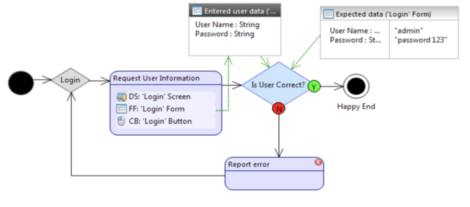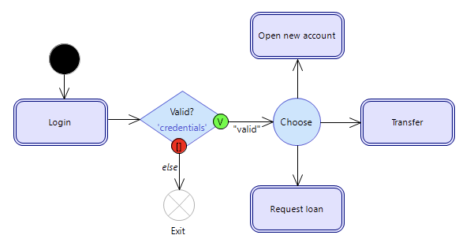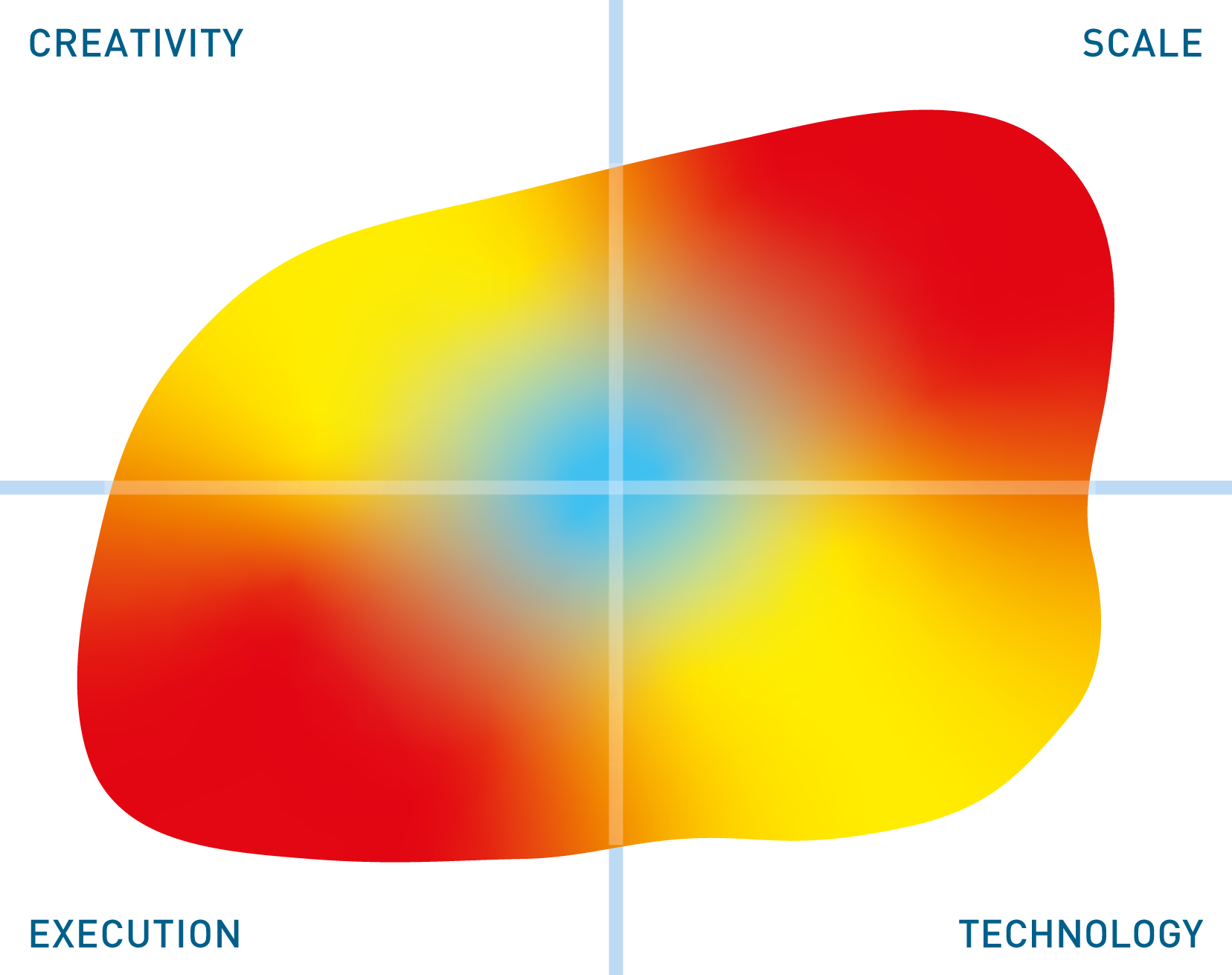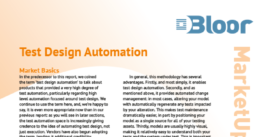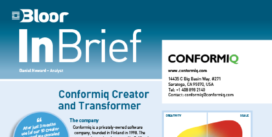Conformiq
Last Updated:
Analyst Coverage: Daniel Howard and Philip Howard
Conformiq is a privately-owned software company, founded in Finland in 1998. The company is now headquartered in California, though research and development continue in Helsinki (and also in Bangalore). The company has offices in Paris and, in conjunction with a support partner in India, is able to offer 24×7 support across the globe.
Conformiq has a number of go-to-market and technology partners, including Micro Focus, IBM, Parasoft, Tricentis, and Eggplant, and the company has also integrated its products with those of many other vendors.
Conformiq
Last Updated: 12th April 2018
Conformiq delivers technology software that automates end to end testing. Its tools are designed to make all of today’s functional testing tools better, by eliminating the manual steps in the test design, data selection, and execution processes. More specifically, Conformiq focuses on providing solutions for Enterprise and IT software testing. These tools are Conformiq Creator for the automatic creation, design, and generation of executable test scripts, with validation. In addition, it can reverse engineer manual tests for new test design purposes. Conformiq’s independent but complimentary tool, Conformiq Transformer, simplifies the path to automated test execution through generated keywords. It also can reverse engineer manual tests for direct automated execution in Micro Focus UFT or Selenium.
The Conformiq suite of tools can be used to test applications of many different types including UI, desktop, API, web services, back office, mainframe, mobile, packaged applications, and combinations of these.
Conformiq’s main go to market approach is to partner with global testing services companies so that the end customer receives a complete solution. However, many companies utilise multiple service partners or want to deliver their own testing services and to support these companies Conformiq has a global sales team.
Conformiq has an “integrate with everything” strategy so that users can leverage their existing tool assets while eliminating any capability gaps. To support this strategy Conformiq has a large list of technology partners and continually adds to the list as new customer and partner requests are made. These software partners include Micro Focus, Atlassian, CA, IBM, Microsoft, Parasoft, Egg Plant and Tricentis, from a testing perspective; as well as modelling tools that include Aris (Software AG), Microsoft Visio, and Sparx Systems amongst others.
Conformiq has users worldwide and focuses on the Fortune 1000, so most customers are located in North America. These customers usually have global operations and very often captive test centres, usually in India.
Conformiq’s customers are primarily those testing “mission critical” applications where errors would represent major financial losses or liabilities. Thus, many of Conformiq’s customers are banks, insurance, and other financial services companies. Additionally, logistics, communications service providers, pharmaceutical, and healthcare companies use Conformiq software. Note that there are no vertical application limitations to the software and other vertical market segments such as retail, technology, media, and travel (including hotels) are potential fits to leverage Conformiq capabilities.
Conformiq user starts by deploying Creator to create a graphical representation (“model”) of the application to be tested. The technology also includes the ability to automatically create these models from existing testing assets. This model can begin with simple business requirements and/or Gherkin feature files that might be created by a business analyst. The graphical flow is reviewed by all project members and stakeholders to ensure everyone understands the expected operation. The model is created in two parts: an activity diagram made by dragging and dropping objects onto the canvas and a structure diagram of the actions occurring in each activity object, such as click button, fill form, etc. As further details become known and/or changes are made over the course of the project, the model can be changed to match, and tests generated or regenerated for manual or automated test execution (depending on the model details). As user operation details become known, these are added to the model and provide the ability to generate fully executable scripts directly for automated execution.
When you decide to generate tests, you select the coverage option most suitable for your project and Creator automatically generates optimised executable test scripts, test validations, and test data, which can - again - be automatically executed via third party test frameworks, or Conformiq Transformer will automate the link to the execution tool. As tests can be generated on the fly without complete or finalised models for progression execution, it is well suited for agile CI/CD development.
This full automation is at the heart of Conformiq’s value proposition: that you should never (emphasis: never) have to fall back on manual coding. As far as we know, Conformiq is unique in providing this capability: it generates executable test scripts, test validations, and test data all directly from the model of the system under test for direct automated execution. This end to end automation enables major efficiency gains over both traditional manual testing methods and test execution tools which lack the capability to automatically generate optimised test cases and scripts.
Conformiq services focus on training for tool use and best practices for both testing partners and end customer companies. Conformiq utilises an onshore/offshore support model similar to that used by global testing services companies. This allows Conformiq to staff support close to its actual tool users rather than just near its sales force. Due to Conformiq’s distributed support structure, global 24x7 support is available in or near customer operation times.
Conformiq Creator and Transformer
Last Updated: 5th February 2020
Conformiq Creator and Conformiq Transformer together form a test design automation solution that models your system as an activity diagram and thereby generates test cases, test data, executable test scripts, and other testing assets automatically. They can also be deployed separately, are Eclipse based, and run on either Windows or Linux.
Other Conformiq products include Conformiq Designer (similar to Conformiq Creator but for embedded systems rather than free-standing applications), Conformiq Grid (a cloud-based offering that runs across multiple CPUs to support test generation in either Conformiq Creator or Conformiq Designer) and Conformiq AutomatIQ. AutomatIQ is particularly interesting: it uses AI and natural language processing to automatically generate executable test scripts directly from your manual test cases and/or Micro Focus ALM test plans without requiring you to create a model. What’s more, a very similar process can be used by Conformiq Creator to reverse engineer your model from your manual tests. This makes AutomatIQ an excellent way to accelerate your adoption of test design automation, and particularly of Conformiq Creator.
Customer Quotes
“After just 3 months use [of our 10 Creator licenses] we cancelled our staffing plans for
50 additional testers saving $1.25M.”
Service provider for NA Bank
“The quantitative benefit from Conformiq was the time it took to create 1,200 test cases. It originally took 420 hours and with Conformiq it took 70 hours.”
NA healthcare insurance company
Conformiq Creator allows you to visually model your system under test using an activity diagram, as shown in Figure 1. This diagram can be created in several ways: by dragging and dropping objects onto a palette, by importing an activity diagram from another tool (such as Microsoft Visio, Gherkin feature files, or Excel), or by automatically reverse engineering existing test cases, BPMN drawings, Gherkin user stories and so on, in the process resolving logical inconsistencies and identifying redundant tests. Models can call other models, enabling sub flows, and test data can be defined either within your model or an external spreadsheet. You can also synchronise your model with requirements brought in from a number of third-party products, including Micro Focus ALM, CA Agile Central and Atlassian JIRA. Alternatively, you can create requirements directly within Conformiq Creator. In the former case, this provides requirements traceability, which can be displayed visually as part of your model.
Using your completed model, you can automatically generate a suite of test cases that are optimised for one of several coverage models. In turn, these test cases can be exported to Conformiq Transformer, to a third-party test automation or test management framework, or even as documentation or manual tests. Automated change management is also available. In addition, Conformiq Creator allows you to create a high level, business requirements model of your system’s operation (see Figure 2) that is useful for understanding your model (and therefore your system), particularly for nontechnical users.
Conformiq Transformer is an automated test execution framework that uses a keyword-based test automation system to generate executable test scripts from your existing test cases, including manual tests, where each keyword corresponds to a series of actions within your application. The keywords themselves can be created either by writing code or by utilising the built-in UI inspector to record interactions in your browser. Keywords can also be parameterised, enabling reuse. Moreover, if you import your test cases from Conformiq Creator, all of the keywords necessary to create executable test scripts from them are created for you. Essentially this means that if you use both products in conjunction, you can create executable test scripts from your test cases, and therefore from your model, automatically, without needing to record actions or write code at any point in the process.
The system model that Conformiq Creator uses is exceptionally detailed and comprehensive. In combination with Conformiq Transformer, it allows you to automatically generate all of your testing assets, including executable test scripts, test data and test validations without writing any code. This provides an extremely high level of automation and correspondingly large gains to productivity and efficiency. It also positions your model as a single source for all of your testing assets. This should make them substantially easier to maintain, particularly in concert with the automated change management provided by the product.
That said, this approach has its downsides. Conformiq models are, by necessity, highly complex, and can therefore be relatively difficult to build and understand, particularly if you are nontechnical. However, these difficulties are ameliorated significantly by being able to generate your initial model from your existing test cases, as well as the ability to create a business requirements model. The former in particular represents a potentially very large time saver, although readers are cautioned that Conformiq operates on a ‘garbage in, garbage out’ policy in regards to incomplete or incorrect test cases, which will therefore need to be detected and dealt with manually.
Finally, the breadth of integration that Conformiq offers is significant. The number of products that Conformiq will integrate with across a range of spaces means that it should be relatively easy to slot Conformiq Creator and Conformiq Transformer into your existing testing environment. This even extends to the two products each being deployable as a standalone solution. In this regard, they are both capable. However, their most significant strengths are only going to be realised when they are deployed together.
The Bottom Line
Conformiq Creator and Transformer allow you to leverage a highly detailed model to automatically generate, and subsequently execute, all of your testing assets. The degree of automation provided is high, and the product(s) as a whole should not be overlooked.
Commentary
Coming soon.


